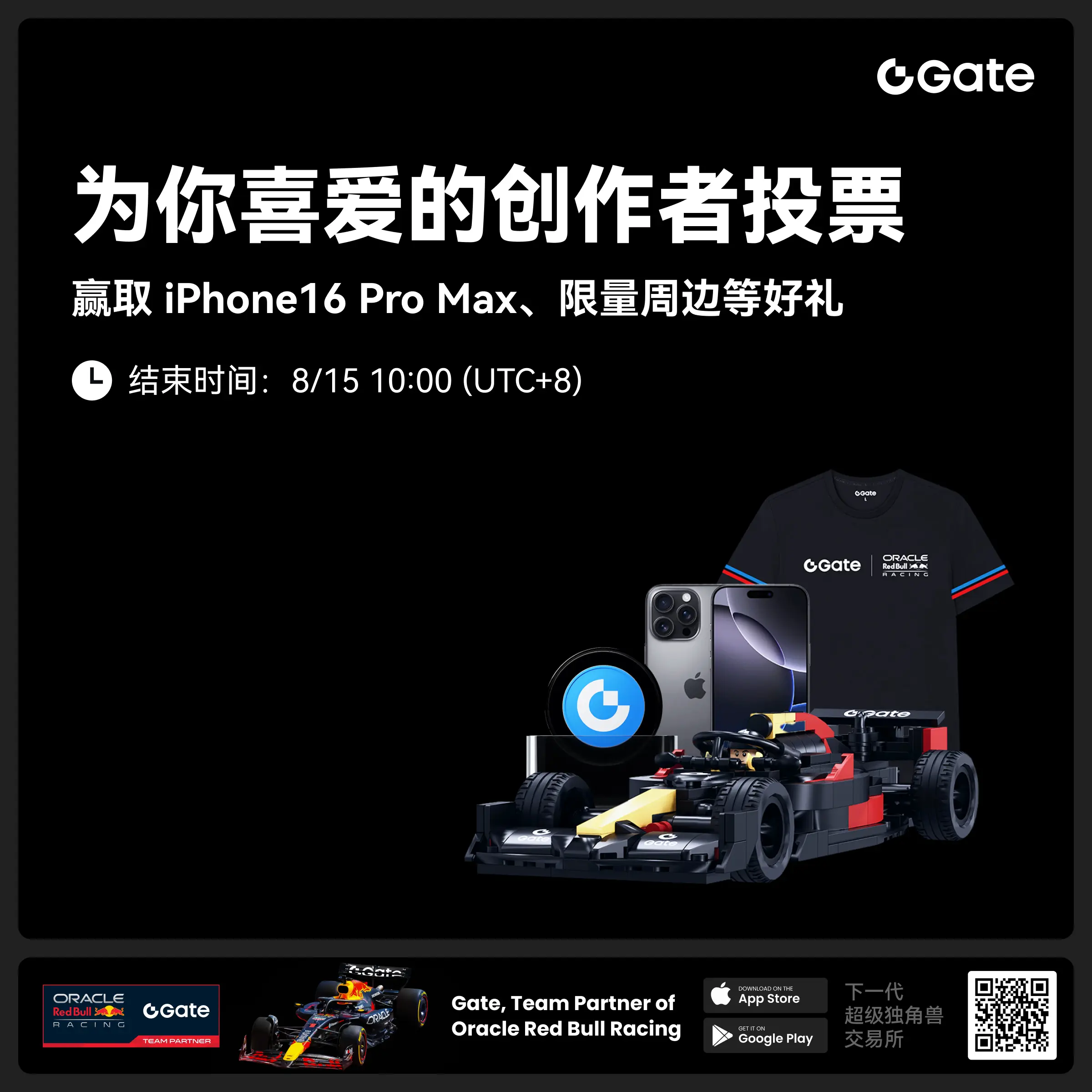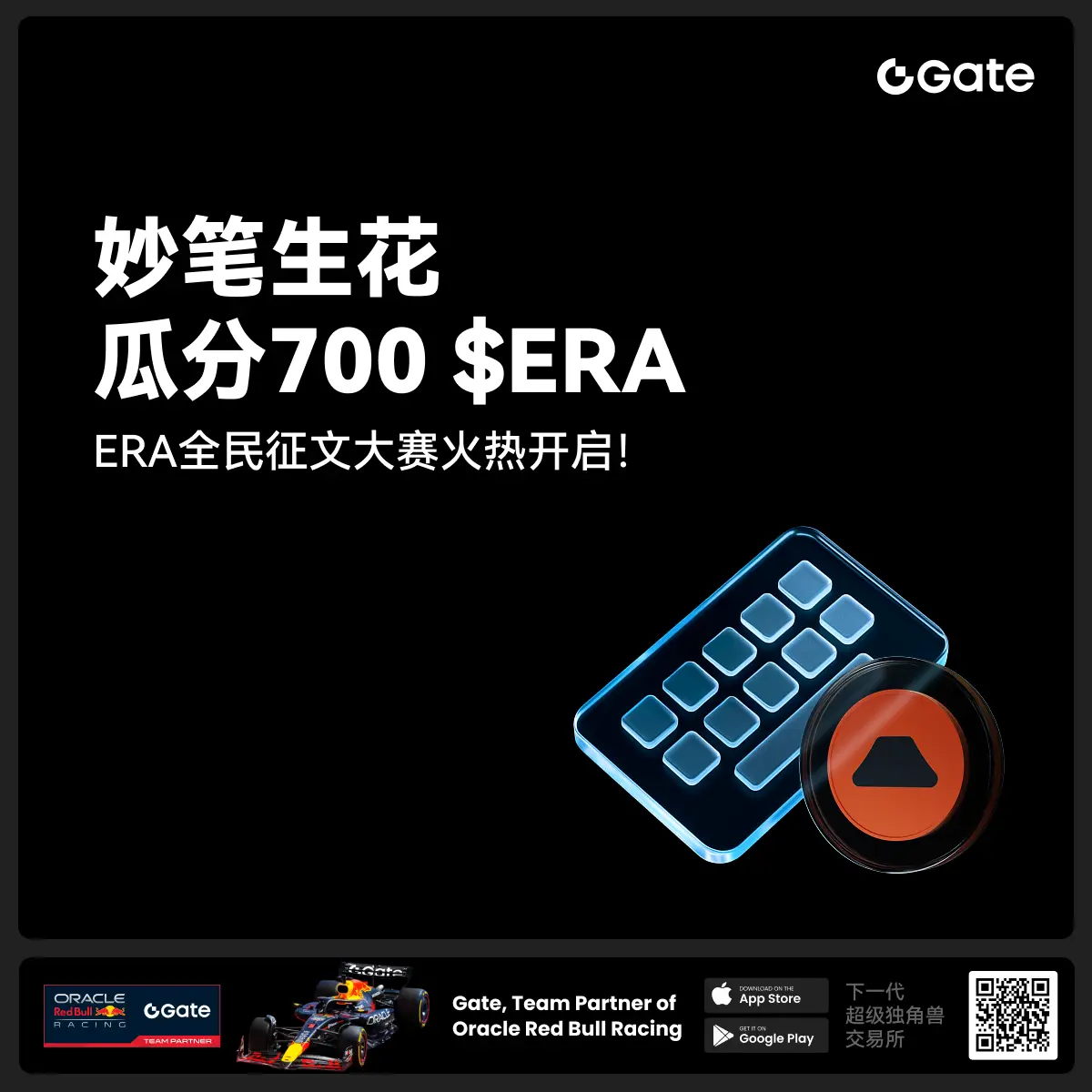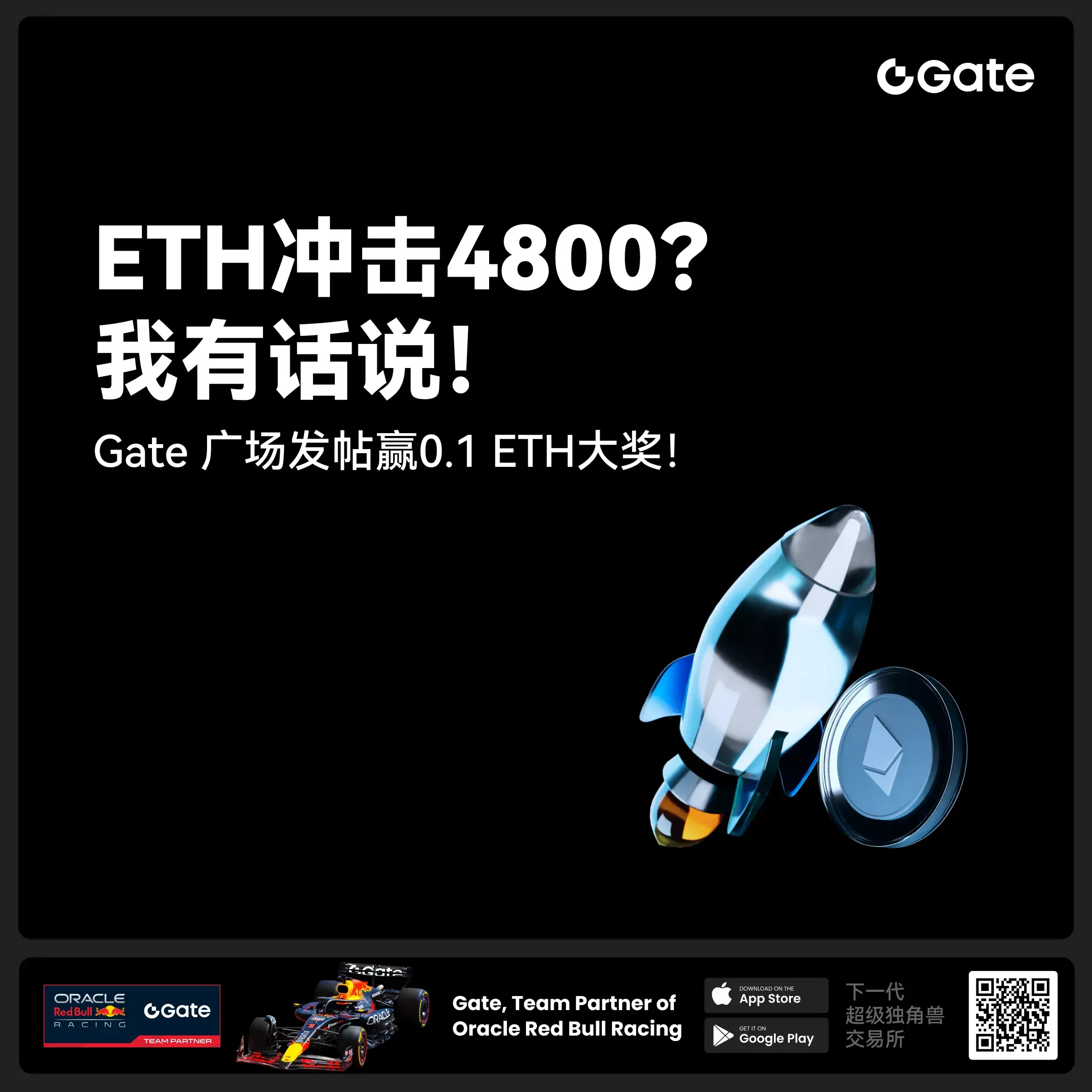更多
- 話題1/3
12k 熱度
21k 熱度
21k 熱度
8k 熱度
4k 熱度
- 置頂
- 🎉Gate 2025 上半年社區盛典:內容達人評選投票火熱進行中 🎉
🏆 誰將成爲前十位 #Gate广场# 內容達人?
投票現已開啓,選出你的心頭好
🎁贏取 iPhone 16 Pro Max、限量週邊等好禮!
📅投票截止:8 月 15 日 10:00(UTC+8)
立即投票: https://www.gate.com/activities/community-vote
活動詳情: https://www.gate.com/announcements/article/45974
- 📢 #Gate广场征文活动第二期# 正式啓動!
分享你對 $ERA 項目的獨特觀點,推廣ERA上線活動, 700 $ERA 等你來贏!
💰 獎勵:
一等獎(1名): 100枚 $ERA
二等獎(5名): 每人 60 枚 $ERA
三等獎(10名): 每人 30 枚 $ERA
👉 參與方式:
1.在 Gate廣場發布你對 ERA 項目的獨到見解貼文
2.在貼文中添加標籤: #Gate广场征文活动第二期# ,貼文字數不低於300字
3.將你的文章或觀點同步到X,加上標籤:Gate Square 和 ERA
4.徵文內容涵蓋但不限於以下創作方向:
ERA 項目亮點:作爲區塊鏈基礎設施公司,ERA 擁有哪些核心優勢?
ERA 代幣經濟模型:如何保障代幣的長期價值及生態可持續發展?
參與並推廣 Gate x Caldera (ERA) 生態周活動。點擊查看活動詳情:https://www.gate.com/announcements/article/46169。
歡迎圍繞上述主題,或從其他獨特視角提出您的見解與建議。
⚠️ 活動要求:
原創內容,至少 300 字, 重復或抄襲內容將被淘汰。
不得使用 #Gate广场征文活动第二期# 和 #ERA# 以外的任何標籤。
每篇文章必須獲得 至少3個互動,否則無法獲得獎勵
鼓勵圖文並茂、深度分析,觀點獨到。
⏰ 活動時間:2025年7月20日 17
- 📢 ETH衝擊4800?我有話說!快來“Gate廣場”秀操作,0.1 ETH大獎等你拿!
牛市預言家,可能下一個就是你!想讓你的觀點成爲廣場熱搜、贏下ETH大獎?現在就是機會!
💰️ 廣場5位優質發帖用戶+X瀏覽量前5發帖用戶,瓜分0.1 ETH!
🎮 活動怎麼玩,0門檻瓜分ETH!
1.話題不服來辯!
帶 #ETH冲击4800# 和 #ETH# 在 廣場 或 K線ETH下 圍繞一下主題展開討論:
-ETH是否有望突破4800?
-你看好ETH的原因是什麼?
-你的ETH持倉策略是?
-ETH能否引領下一輪牛市?
2. X平台同步嗨
在X平台發帖討論,記得帶 #GateSquare# 和 #ETH冲击4800# 標籤!
把你X返連結提交以下表單以瓜分大獎:https://www.gate.com/questionnaire/6896
✨發帖要求:
-內容須原創,字數不少於100字,且帶活動指定標籤
-配圖、行情截圖、分析看法加分,圖文並茂更易精選
-禁止AI寫手和灌水刷屏,一旦發現取消獎勵資格
-觀點鮮明、邏輯清晰,越有料越好!
關注ETH風向,創造觀點價值,從廣場發帖開始!下一個牛市“預言家”,可能就是你!🦾🏆
⏰ 活動時間:2025年7月18日 16:00 - 2025年7月28日 23:59(UTC+8)
【立即發帖】 展現你的真知灼見,贏取屬於你的ETH大獎!
- 🎉【Gate 3000萬紀念】曬出我的Gate時刻,解鎖限量好禮!
Gate用戶突破3000萬!這不僅是數字,更是我們共同的故事。
還記得第一次開通帳號的激動,搶購成功的喜悅,或陪伴你的Gate週邊嗎?
📸 參與 #我的Gate时刻# ,在Gate廣場曬出你的故事,一起見證下一個3000萬!
✅ 參與方式:
1️⃣ 帶話題 #我的Gate时刻# ,發布包含Gate元素的照片或視頻
2️⃣ 搭配你的Gate故事、祝福或感言更佳
3️⃣ 分享至Twitter(X)可參與瀏覽量前10額外獎勵
推特回鏈請填表單:https://www.gate.com/questionnaire/6872
🎁 獨家獎勵:
🏆 創意大獎(3名):Gate × F1紅牛聯名賽車模型一輛
👕 共創紀念獎(10名): 國際米蘭同款球員衛衣
🥇 參與獎(50名):Gate 品牌抱枕
📣 分享獎(10名):Twitter前10瀏覽量,送Gate × 國米小夜燈!
*海外用戶紅牛聯名賽車折合爲 $200 合約體驗券,國米同款球衣折合爲 $50 合約體驗券,國米小夜燈折合爲 $30 合約體驗券,品牌抱枕折合爲 $20 合約體驗券發放
🧠 創意提示:不限元素內容風格,曬圖帶有如Gate logo、Gate色彩、週邊產品、GT圖案、活動紀念品、活動現場圖等均可參與!
活動截止於7月25日 24:00 UTC+8
3
深度解析Chromia向量數據庫:AI與區塊鏈如何融合?
本報告由Tiger Research撰寫,分析了Chromia的向量數據庫實現作爲AI與區塊鏈技術融合的案例。
要點總結
1. AI與區塊鏈融合的現狀
來源:Kiyotaka
AI與區塊鏈的交匯長期吸引着行業關注。中心化的AI系統仍面臨透明度、可靠性及成本可預測性等挑戰——而這些領域常被視爲區塊鏈的潛在解決方案。
**盡管AI代理市場在2024年末爆發,但大多數項目僅實現了兩種技術的表面級整合。**許多舉措依賴加密貨幣的投機興趣獲取資金和曝光,而非探索與Web3的深度技術或功能協同。因此,衆多項目的估值已從峯值下跌超過90%。
**AI與區塊鏈難以實現實質性協同的根源在於多個結構性難題。**其中最突出的是鏈上數據處理的復雜性——數據依然零散、技術波動性強。若數據訪問與利用能像傳統系統般簡單,行業或許早已取得更清晰的成果。
**這一困境類似羅密歐與朱麗葉的劇本:**兩種來自不同領域的強大技術缺乏共同語言或真正的融合交匯點。日益明顯的是,行業需要一種能彌合鴻溝的基礎設施——既能互補AI與區塊鏈的優勢,又能作爲兩者的交匯點。
應對這一挑戰需要兼具成本效益與高性能的系統,以匹配現有中心化工具的可靠性。在此背景下,支撐當今多數AI創新的向量數據庫技術正成爲關鍵賦能者。
2. 向量數據庫的必要性
隨着AI應用普及,向量數據庫因解決傳統數據庫系統的局限性而嶄露頭角。這些數據庫通過將文本、圖像、音頻等復雜數據轉化爲稱爲“向量”的數學表示形式進行存儲。由於基於相似性(而非精確性)檢索數據,向量數據庫比傳統數據庫更貼合AI對語言和上下文的理解邏輯。
來源:weaviate
傳統數據庫如同圖書館目錄——僅返回包含“kitten”一詞的書籍,而向量數據庫可呈現“cat”“dog”“wolf”等相關內容。這得益於系統以數值向量形式存儲信息,捕捉基於概念相似性(而非精確措辭)的關系。
以對話爲例:當被問“你今天心情如何?”時,若回答“天空格外晴朗”,我們仍能理解其積極情緒——盡管未使用明確的情感詞匯。向量數據庫以類似方式運作,使系統能解讀潛在含義而非依賴直接詞匯匹配。這模擬了人類認知模式,實現更自然智能的AI交互。
在Web2中,向量數據庫的價值已獲廣泛認可。Pinecone(1億美元)、Weaviate(5000萬美元)、Milvus(6000萬美元)和Chroma(1800萬美元)等平台已獲巨額投資。相比之下,Web3始終難以開發可比解決方案,使得AI與區塊鏈的融合更多停留在理論層面。
3. Chromia鏈上向量數據庫的願景
來源:Tiger Research
Chromia——基於PostgreSQL構建的Layer1關系型區塊鏈——憑借結構化數據處理能力和開發者友好環境脫穎而出。依托其關系型數據庫基礎,Chromia已開始探索區塊鏈與AI技術的深度整合。
近期裏程碑是“Chromia擴展”的推出,該擴展集成了PgVector(一種在PostgreSQL數據庫內廣泛使用的開源向量相似性搜索工具)。PgVector支持高效查詢相似文本或圖像,爲AI驅動型應用提供明確實用性。
PgVector在傳統技術生態中已根基穩固。常被視爲主流數據庫服務Firebase替代品的Supabase,使用PgVector支持高性能向量搜索。其在PostgreSQL平台上的日益普及,反映了行業對該工具的廣泛信心。
**通過整合PgVector,Chromia將向量搜索能力引入Web3,使其基礎設施與傳統技術棧已驗證的標準對齊。**這一整合在2025年3月的Mimir主網升級中發揮核心作用,被視爲邁向AI-區塊鏈無縫互操作的基礎一步。
3.1 一體化集成環境:區塊鏈與AI的完全融合
**開發者嘗試結合區塊鏈與AI的最大挑戰是復雜性。**在現有區塊鏈上創建AI應用需連接多個外部系統的復雜流程。例如,開發者需在鏈上存儲數據、在外部服務器運行AI模型,並構建獨立向量數據庫。
這種碎片化結構導致低效運作。用戶查詢在鏈外處理,數據需在鏈上鏈下環境間持續遷移。這不僅增加開發時間與基礎設施成本,還造成嚴重安全漏洞——系統間數據傳輸加劇黑客攻擊風險並降低整體透明度。
Chromia通過將向量數據庫直接集成至區塊鏈,提供了根本性解決方案。在Chromia上,所有處理均在鏈內完成:用戶查詢被轉化爲向量,直接在鏈內搜索相似數據並返回結果,實現全流程單環境處理。
來源:Tiger Research
以簡單類比說明:過去開發者需分別管理組件——如同烹飪需購買鍋、平底鍋、攪拌機和烤箱。Chromia通過提供多功能料理機簡化流程,將所有功能集成至單一系統。
這種集成方法極大簡化開發流程。無需外部服務與復雜連接代碼,減少開發時間與成本。此外,所有數據與處理均記錄於鏈上,確保完全透明。這標志着區塊鏈與AI完全融合的開端。
3.2 成本效率:相比現有服務的卓越價格競爭力
**普遍存在一種成見:鏈上服務“不便且昂貴”。**尤其在傳統區塊鏈模型中,每筆交易產生燃料費、擁堵鏈上成本激增的結構性缺陷顯著。成本不可預測性成爲企業採用區塊鏈解決方案的主要障礙。
來源:Chromia
**Chromia通過高效架構與差異化商業模式解決痛點。**不同於傳統區塊鏈的燃料費模式,Chromia引入服務器計算單元(SCU)租賃系統——類似AWS或Google Cloud的定價結構。這種實例化模式與熟悉的雲服務定價一致,消除了區塊鏈網絡常見的成本波動。
具體而言,用戶可使用Chromia原生代幣$CHR按周租賃SCU。每個SCU提供16GB基準存儲,成本隨用量線性擴展。SCU可根據需求彈性調整,實現靈活高效的資源分配。該模式在保持網絡去中心化的同時,融入Web2服務可預測的用量計價——大幅提升成本透明度與效率。
來源:Chromia, Tiger Research
**Chromia向量數據庫進一步強化成本優勢。**據內部基準測試,該數據庫月運營成本爲727美元(基於2個SCU與50GB存儲)——比同類Web2向量數據庫解決方案低57%。
這一價格競爭力源於多重結構效率。Chromia受益於將PgVector適配鏈上環境的技術優化,但更大影響來自其去中心化資源供應模式。傳統服務在AWS或GCP基礎設施上疊加高服務溢價,而Chromia通過節點運營商直接提供算力與存儲,減少中間層及相關成本。
分布式結構也提升服務可靠性。多節點並行運作使網絡天然具備高可用性——即使個別節點故障。因此,Web2 SaaS模式中典型的高昂高可用性基礎設施與大型支持團隊需求顯著降低,既降低運營成本又增強系統韌性。
4. 區塊鏈與AI融合的開端
盡管推出僅一個月,Chromia向量數據庫已顯現早期吸引力,多個創新用例正在開發中。爲加速採用,Chromia通過資助覆蓋向量數據庫使用成本,積極支持建設者。
這些資助降低實驗門檻,允許開發者以更低風險探索新想法。潛在應用涵蓋AI集成DeFi服務、透明內容推薦系統、用戶自有數據共享平台及社區驅動知識管理工具。
來源:Tiger Research
假設案例如Tiger Labs開發的“AI Web3研究樞紐”。該系統利用Chromia基礎設施將研究內容與Web3項目鏈上數據轉化爲向量嵌入,供AI代理提供智能服務。
這些AI代理可通過Chromia向量數據庫直接查詢鏈上數據,實現顯著加速響應。結合Chromia的EVM索引能力,系統可分析以太坊、BNB Chain、Base等鏈上活動——支持廣泛項目。值得注意的是,用戶對話上下文存儲於鏈上,爲投資者等終端用戶提供完全透明的推薦流。
來源:Tiger Research
隨着多樣化用例增長,更多數據持續生成並存儲於Chromia——爲“AI飛輪”奠定基礎。來自區塊鏈應用的文本、圖像及交易數據以結構化向量形式存儲於Chromia數據庫,形成豐富的AI可訓練數據集。
**這些積累數據成爲AI核心學習材料,驅動性能持續提升。**例如,從海量用戶交易模式中學習的AI可提供更精準定制化財務建議。這些先進AI應用通過增強用戶體驗吸引更多用戶,用戶增長又將催生更豐富數據積累,形成生態持續發展的閉環。
5. Chromia的路線圖
繼Mimir主網上線後,Chromia將聚焦三大領域:
5.1 EVM索引創新
區塊鏈的固有復雜性長期是開發者的主要障礙。爲此,Chromia推出以開發者爲核心的創新索引方案,旨在從根本上簡化鏈上數據查詢。目標明確:通過大幅提升查詢效率與靈活性,使區塊鏈數據更易獲取。
這一方法代表以太坊NFT交易追蹤方式的重大轉變。Chromia動態學習數據模式與結構,取代剛性預定義查詢結構,從而識別最高效的信息檢索路徑。遊戲開發者可即時分析鏈上道具交易歷史,DeFi項目可快速追蹤復雜交易流。
5.2 AI推理能力擴展
前述數據索引進展爲Chromia擴展AI推理能力奠定基礎。項目已在測試網成功上線首個AI推理擴展,重點支持開源AI模型。值得注意的是,Python客戶端的引入大幅降低在Chromia環境集成機器學習模型的難度。
這一發展超越技術優化,體現了與AI模型創新快節奏的戰略對齊。通過支持在供應商節點直接運行日益多樣化的強大AI模型,Chromia旨在突破分布式AI學習與推理的邊界。
5.3 開發者生態擴展策略
Chromia正積極建立合作,釋放向量數據庫技術全部潛力,重點聚焦AI驅動型應用開發。這些努力旨在提升網絡效用與需求。
公司瞄準AI研究代理、去中心化推薦系統、上下文感知文本搜索及語義相似性搜索等高影響力領域。該計劃超越技術支持——創建開發者可構建真實用戶價值應用的平台。此前增強的數據索引與AI推理能力有望成爲這些應用開發的核心引擎。
6. Chromia的願景與市場挑戰
**Chromia的鏈上向量數據庫使其成爲區塊鏈-AI融合領域的領先競爭者。**其創新方法——直接鏈上集成向量數據庫——在其他生態中尚未實現,凸顯明確技術優勢。
平台的雲式SCU租賃模式也爲習慣燃料費體系的開發者引入誘人範式轉變。這種可預測且優化的成本結構尤其適合大規模AI應用,構成關鍵差異化點。值得注意的是,使用成本比Web2向量數據庫服務低約57%,顯著增強Chromia市場競爭力。
**盡管如此,Chromia面臨關鍵挑戰——尤其是市場認知與生態增長。**向開發者與企業傳達其原生編程語言(Rell)及鏈上AI集成等復雜創新至關重要。保持領先地位需持續技術開發與生態擴展,尤其當其他區塊鏈平台開始瞄準同類用例時。
**長期成功取決於驗證實際用例與確保代幣經濟模型的可持續性。**SCU租賃模式對代幣長期價值的影響、有效開發者採用策略及實質性商業應用案例的創建,將是Chromia未來發展的決定性因素。
Chromia在新興Web3-AI融合領域已建立早期領導地位。然而,將技術差異轉化爲持久市場價值需在基礎設施、生態與傳播層面持續進步。未來12-24個月將對塑造Chromia長期軌跡至關重要。
原文連結